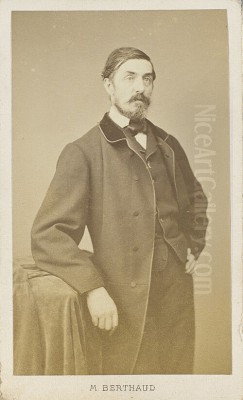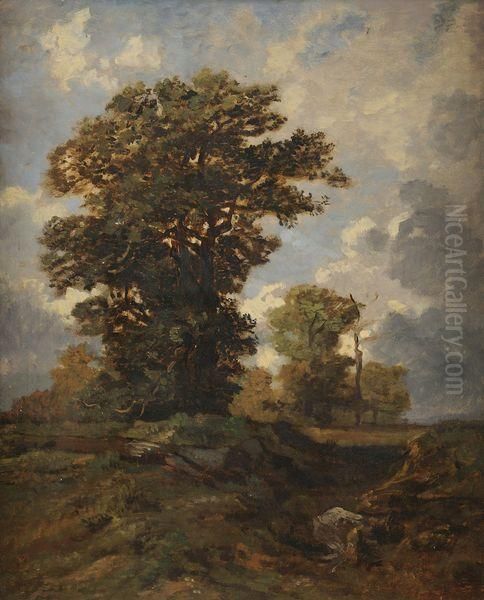
Auguste Paul Charles Anastasi stands as a notable, if sometimes underappreciated, figure in the rich tapestry of 19th-century French art. Born in Paris on November 15, 1820, and passing away in the same city on March 15, 1889, Anastasi dedicated his life to capturing the nuances of the natural world, first as a painter and later, with poignant resilience, as a printmaker. His association with the influential Barbizon School, his tutelage under renowned masters, and his unwavering commitment to his craft, even in the face of profound personal adversity, define his artistic journey. This exploration delves into the life, work, and enduring legacy of a man who, despite the eventual loss of his sight, never lost his artistic vision.
Early Life and Artistic Formation in Paris
Paris, the vibrant heart of the European art world in the 19th century, was the cradle of Anastasi's artistic development. He was fortunate to receive his formal training at the prestigious École des Beaux-Arts, the leading art institution in France. This academic grounding provided him with a solid foundation in drawing, composition, and the classical traditions that still held considerable sway. However, it was his apprenticeships under two distinct yet equally influential masters that would more profoundly shape his artistic trajectory: Paul Delaroche and Jean-Baptiste-Camille Corot.
Paul Delaroche (1797-1856) was a preeminent historical painter, celebrated for his meticulously rendered and dramatically charged scenes from French and English history. His studio was a magnet for aspiring artists, and under his guidance, Anastasi would have honed his technical skills, particularly in figure drawing and the construction of complex compositions. While Anastasi would ultimately gravitate towards landscape, Delaroche's emphasis on narrative clarity and polished execution likely left an imprint on his approach to structuring his canvases.

Perhaps more pivotal to Anastasi's development as a landscapist was his relationship with Jean-Baptiste-Camille Corot (1796-1875). Corot was a towering figure in French landscape painting, revered for his poetic and light-filled depictions of nature. He was a key precursor to Impressionism and a central figure in the Barbizon School. From Corot, Anastasi would have absorbed a deep appreciation for plein air (open-air) painting, the subtle observation of atmospheric effects, and a lyrical approach to landscape. Corot's influence is palpable in Anastasi's sensitivity to light and his ability to imbue his scenes with a gentle, often melancholic, charm.
The Barbizon School and Anastasi's Connection
Auguste Anastasi is rightly identified as a member of the Barbizon School, a movement that revolutionized landscape painting in France from roughly the 1830s to the 1870s. Named after the village of Barbizon, located near the Forest of Fontainebleau, this informal group of artists rejected the idealized and historical landscapes favored by the Academy. Instead, they sought a more direct, truthful, and personal engagement with nature, often painting outdoors to capture its fleeting moods and authentic character.
The Barbizon painters emphasized realism, though not in a stark, photographic sense. Their realism was imbued with a romantic sensibility, a deep reverence for the rustic beauty of the French countryside, and an appreciation for the lives of the peasants who worked the land. Key figures associated with the Barbizon School, alongside Corot, include Théodore Rousseau, known for his powerful depictions of the Forest of Fontainebleau; Jean-François Millet, famous for his dignified portrayals of peasant life; Charles-François Daubigny, who often painted from his studio boat on the Oise River; Narcisse Virgilio Díaz de la Peña, celebrated for his richly colored forest interiors and mythological scenes; and Jules Dupré, whose dramatic seascapes and landscapes captured nature's power. Constant Troyon was another prominent member, particularly known for his animal paintings set within realistic landscapes.
Anastasi's involvement with the Barbizon School aligned with his own inclination towards naturalistic landscape. He shared their commitment to observing nature firsthand and translating its essence onto canvas. His works often depict the forests, fields, and waterways that were the cherished subjects of his Barbizon contemporaries, rendered with an attention to atmospheric detail and a quiet, contemplative mood.
Artistic Style: Painting and Printmaking
Anastasi's artistic style, while rooted in the Barbizon ethos, possessed its own distinct characteristics. His paintings generally leaned towards a classical sense of composition, likely a lingering influence from his studies at the École des Beaux-Arts and with Delaroche. This structural underpinning was combined with a realistic depiction of natural elements. However, critics and art historians have sometimes noted that his works, while attractive and skillfully executed, could occasionally tend towards a certain surface quality or decorative flatness. This doesn't diminish their appeal but rather situates them within a particular aesthetic sensibility of the time, one that valued charm and picturesque qualities.
He was particularly adept at capturing the play of light, whether it was the soft glow of a sunset, the dappled light filtering through forest leaves, or the broader illumination of an open landscape. His color palette was generally harmonious and naturalistic, reflecting the observed hues of the French countryside.
Later in his career, particularly as his eyesight began to fail, Anastasi increasingly turned his attention to printmaking, especially lithography. Lithography, a planographic printing process that allows for a wide range of tonal effects, proved to be a suitable medium for his artistic expression. His prints often exhibit a greater sense of drama and stronger contrasts than his paintings. He created original compositions in this medium and also produced lithographs after the works of his contemporaries, a common practice at the time that helped disseminate images to a wider audience. Among the artists whose works he reproduced were the celebrated animal painter Rosa Bonheur, the landscape and marine painter Eugène Isabey, and his Barbizon colleague Théodore Rousseau. This work not only showcased his technical skill as a lithographer but also demonstrated his engagement with the broader artistic currents of his era.
Representative Works: Capturing Nature's Essence
Several works stand out in Auguste Anastasi's oeuvre, illustrating his skill as both a painter and a printmaker.
Les chênes, Forêt de Fontainebleau (Oaks in the Forest of Fontainebleau) is a quintessential Barbizon subject. The Forest of Fontainebleau was a sacred site for these painters, offering an endless variety of motifs, from majestic ancient oaks to intimate woodland clearings. Anastasi's depiction would have focused on the grandeur and enduring presence of these trees, likely employing his characteristic attention to light and atmospheric effect to convey the unique ambiance of the forest. A painting with this title was notably sold at auction in 1873, indicating its contemporary appreciation.
Acqueducs dans la campagne romaine (Aqueducts in the Roman Countryside) is a significant example of his work as a printmaker. The Roman Campagna, with its ancient ruins and expansive landscapes, had long been a magnet for artists. Anastasi's lithograph likely captured the picturesque and historical resonance of these Roman aqueducts, perhaps emphasizing their monumental forms against a dramatic sky, a style well-suited to the expressive potential of lithography. This work demonstrates his talent in translating landscape into the graphic medium.
Le soleil couchant (The Setting Sun) and Lever de soleil sur la Meuse (Sunrise on the Meuse) highlight Anastasi's fascination with the transient effects of light at dawn and dusk. These times of day, with their soft illumination and long shadows, were favored by many landscape painters for their poetic and evocative qualities. Such works would have allowed Anastasi to explore subtle gradations of color and tone, creating moods of tranquility or gentle melancholy.
Another documented work, Bar à Douarnenez (Bar in Douarnenez), was exhibited at the Salon of 1870, held at the Musée des Beaux-Arts in Quimper. Douarnenez, a fishing port in Brittany, would have offered different scenic possibilities, perhaps coastal views or scenes of local life, showcasing a broader geographical range in his subject matter beyond the immediate Parisian environs and Fontainebleau.
His painting Hercule et les oiseaux du lac Stymphale (Hercules and the Stymphalian Birds), sold at auction in Paris at the Hôtel Drouot in 1872, suggests an occasional foray into mythological or historical landscape, perhaps echoing the influence of Delaroche, though landscape would have remained the primary focus.
The Profound Challenge: Blindness and Artistic Adaptation
One of the most compelling and poignant aspects of Auguste Anastasi's life was his gradual loss of sight. His vision began to decline significantly around the 1860s, and by approximately 1868 or 1870, he was forced to abandon painting altogether. For an artist whose entire career was dedicated to visual representation, this must have been a devastating blow. The world of light, color, and form, which he had so diligently observed and translated into his art, was slowly receding from him.
Yet, Anastasi's artistic spirit was not extinguished. In a remarkable display of resilience and determination, he shifted his focus almost entirely to printmaking, particularly lithography. This medium, which could accommodate broader strokes and did not always demand the minute precision of oil painting, allowed him to continue his creative output. His lithographs from this period are often characterized by their dramatic intensity and strong chiaroscuro (contrasts of light and dark), perhaps reflecting both an adaptation to his changing vision and an inner emotional landscape. He continued to produce both original works and interpretations of other artists' paintings, demonstrating an enduring connection to the art world.
This transition underscores not only his personal courage but also the versatility of his artistic skills. To master a new primary medium under such challenging circumstances speaks volumes about his dedication and innate talent.
Recognition, Later Life, and Legacy
Despite the immense challenge of his failing eyesight, Auguste Anastasi received notable recognition for his contributions to French art. In 1868, a pivotal year as his ability to paint was diminishing, he was awarded the Chevalier de la Légion d'honneur (Knight of the Legion of Honour). This prestigious award was a significant acknowledgment of his artistic achievements and his standing within the French art community.
His works continued to be exhibited and sold. The Salon exhibition of Bar à Douarnenez in 1870 and the auction sales of works like Les chênes in 1873 attest to his ongoing presence in the art market. He remained a respected figure, and his ability to continue working as a printmaker allowed him to maintain his artistic voice.
Anastasi was also part of the vibrant social and cultural milieu of Paris. He is known to have attended gatherings with other prominent artistic and literary figures of the time, including the academic painter Paul Baudry, the painter and writer Eugène Fromentin, and the immensely popular illustrator and painter Gustave Doré. These interactions place him within the intellectual currents of his era, sharing company with some of the leading creative minds of 19th-century France.
Auguste Paul Charles Anastasi passed away in Paris on March 15, 1889. His legacy is that of a dedicated landscape artist who contributed to the Barbizon tradition, capturing the beauty of the French countryside with sensitivity and skill. Moreover, his life story is one of remarkable perseverance in the face of adversity. His shift to printmaking after losing his sight is a testament to the enduring power of the creative impulse.
While perhaps not as widely celebrated today as some of his more famous contemporaries like Corot or Millet, Anastasi's work holds an important place in the narrative of 19th-century French landscape art. His paintings and prints offer a window into the artistic concerns of his time and reflect a genuine love for the natural world. His connection to key figures and movements, from the academic halls of the École des Beaux-Arts to the rustic environs of Barbizon, and his courageous adaptation to blindness, make him a compelling figure for art historians and enthusiasts alike. His art continues to be appreciated for its quiet charm, its skillful rendering of light and atmosphere, and the poignant story of the artist behind the vision.